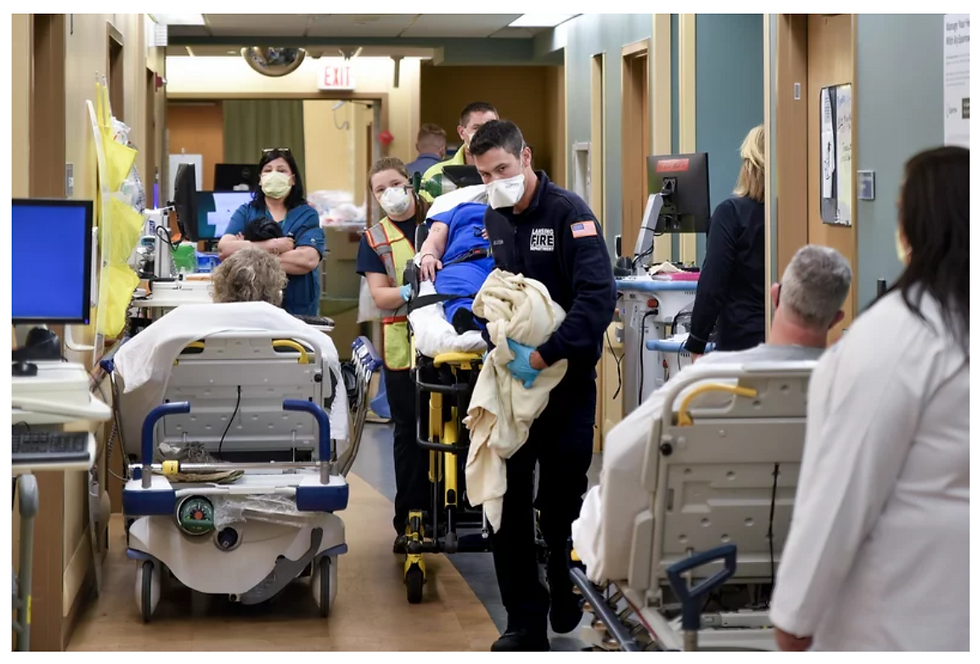Why Do Ostomy Patients Go Back To The Hospital?
- katherinepiette
- Oct 1, 2016
- 4 min read
Updated: Mar 30, 2021

To honor Ostomy Awareness Day on October 1, we're discussing the specific challenges of ostomy care and the various risk factors that can lead to post-op complications and hospital readmittance for ostomy patients.
The Problem
Each year approximately 120,000 people undergo operations that result in an ostomy in the U.S¹ with 36.1% receiving a colostomy, 32,2% receiving an ileostomy, and 31.7% receiving an urostomy². Nearly 800,000 U.S. citizens currently live with an ostomy.¹ Due to the aging population and accompanied rising incidence in colorectal cancer and ulcerative colitis, that number of ostomies is expected to increase at an annual rate of 3%.³ Even though ostomy procedures are commonplace, it is reported that as many as two thirds of these patients experience a complication⁴ often requiring further hospitalization. Ostomy surgeries carry both ‘cost’ to the patient in terms of psychological issues and quality of life and ‘cost’ to the overall healthcare system.
A 2013, Healthcare Cost and Utilization Project (HCUP) publication provides an overview of 30-day all-payer, all-cause readmissions to U.S. hospitals for a range of inpatient procedures in 2010⁵. It presents the most comprehensive national estimates available to date on readmissions by procedure. That study reveals the gravity of the problem:
Ileostomies and enterostomies - 2nd most frequent readmitted procedure - 29.1% readmission rate
Nephrostomies - 4th most frequent readmitted procedure - 24.0% readmission rate
Colostomies ranked #13 - 13th most frequent readmitted procedure - 19.0% readmission rate
Further substantiation is provided by a recent Johns Hopkins study that indicates nearly 25% of privately insured colon surgery patients are readmitted to the hospital within three months of discharge at a cost of approximately $9,000 per readmission and they have identified this a major quality improvement project for cost reduction.⁶
Reasons for high readmission rates
There are multiple reasons for high ostomy readmission rates. On one hand, government and commercial payers have shortened ostomy surgery hospital stays as a cost saving measure. These patients are transitioned to skilled nursing facilities, home with home health, or home to self-manage their post-op care. These providers often lack staff with sufficient knowledge of evidence-based best practice care and efficacious use of ostomy supplies and appliances, resulting in lower quality care for the ostomy patients.
Ostomy related surgeries are complex and pose multiple challenges after surgery with regards to the stoma such as irritation of the surrounding or peri-stomal skin due to leakage of the stool, and structural issues like prolapse, herniation, retractions and necrosis. In addition, there are psychological concerns including depression, feelings of inadequacy, loss of control, etc. Education in the hospital setting is often not sufficient to prepare the patient for the complex issues which they will be dealing with at home.
Benefits of an Ostomy Nurse
Board certified ostomy nurses provide much needed support to ostomy patients. Pre-operatively, ostomy nurses play an important role in identifying and marking the appropriate site for the stoma - the stoma’s placement is critical to reducing some of the post-op surgical challenges. In addition, they provide pre-operative teaching to the patient and caregiver.
Post-operatively, ostomy nurses assist new ostomates with both the physical and psychosocial issues. The challenges of performing daily ostomy care include equipment decisions and troubleshooting, cleaning, skin care, and getting used to wearing an ostomy appliance. With ileostomies in particular, dehydration is a common reason for readmission so patient education includes warning signs of dehydration and accompanying corrective measures.
In addition, ostomy nurses educate on lifestyle challenges associated with having an ostomy such as bathing, swimming, exercising and sexual relations. Patients and caregivers are guided in these psychosocial interventions. The ultimate goal is empowering these patients to self-manage their ostomies and know the signs and symptoms of when to seek medical assistance.
Benefits of CORSTRATA
The use of telehealth in triaging ostomy complications has been demonstrated in numerous studies.⁷ CORSTRATA’s board certified ostomy nurses increase access to expert ostomy care across multiple care settings - skilled nursing facilities, home health, and directly to the patient/caregiver at home. Having access to a CORSTRATA ostomy expert available through live video in the privacy of a patient’s home enables triaging of the numerous ostomy associated complications thereby preventing costly readmissions to the hospital. CORSTRATA uses HIPAA compliant mobile technologies for both photo documentation of the stoma and live video consults.
Sources
¹Pittman J, Rawl SM, Schmidt CM, Grant M, Ko CY, Wendel C, Krouse RS. Demographic and clinical factors related to ostomy complications and quality of life in veterans with an ostomy. J WOCN. 2008;35(5):493–503 ²Turnbull G. The Ostomy FIles: OStomy Statistics: The $64,000 Question. J Ostomy Wound Management. 2003;6 Retrieved from http://www.o-wm.com/content/ostomy-statistics-the-64000-question ³Husain, S. G., & Cataldo, T. E. (2008). Late Stomal Complications. Clinics in Colon and Rectal Surgery, 21(1), 31–40. http://doi.org/10.1055/s-2008-1055319 ⁴Robertson I, Leung E, Hughes D, et al. Prospective analysis of stoma-related complications. Colorectal Dis. 2005;7:279–285. ⁵Weiss AJ (Truven Health Analytics), Elixhauser A (AHRQ), Steiner C (AHRQ). Readmissions to U.S. Hospitals by Procedure, 2010. HCUP Statistical Brief #154. April 2013. Agency for Healthcare Research and Quality, Rockville, MD. Retrieved from http://www.hcup-us.ahrq.gov/reports/statbriefs/sb154.pdf. ⁶John Hopkins Medicine. (2011). Hospital Readmissions After Colon Surgery Common, Costly - and Preventable [Press Release]. Retrieved from http://www.hopkinsmedicine.org/news/media/releases/hospital_readmissions_after_colon_surgery_common_costly___and_preventable ⁷McDonald P, Bohnenkamp S, Krupinski E, Lopez A, Major J. Traditional Versus Telenursing Management of Oncology Patients with New Ostomies. J WOCN, 2003;30(3):S3





Comments